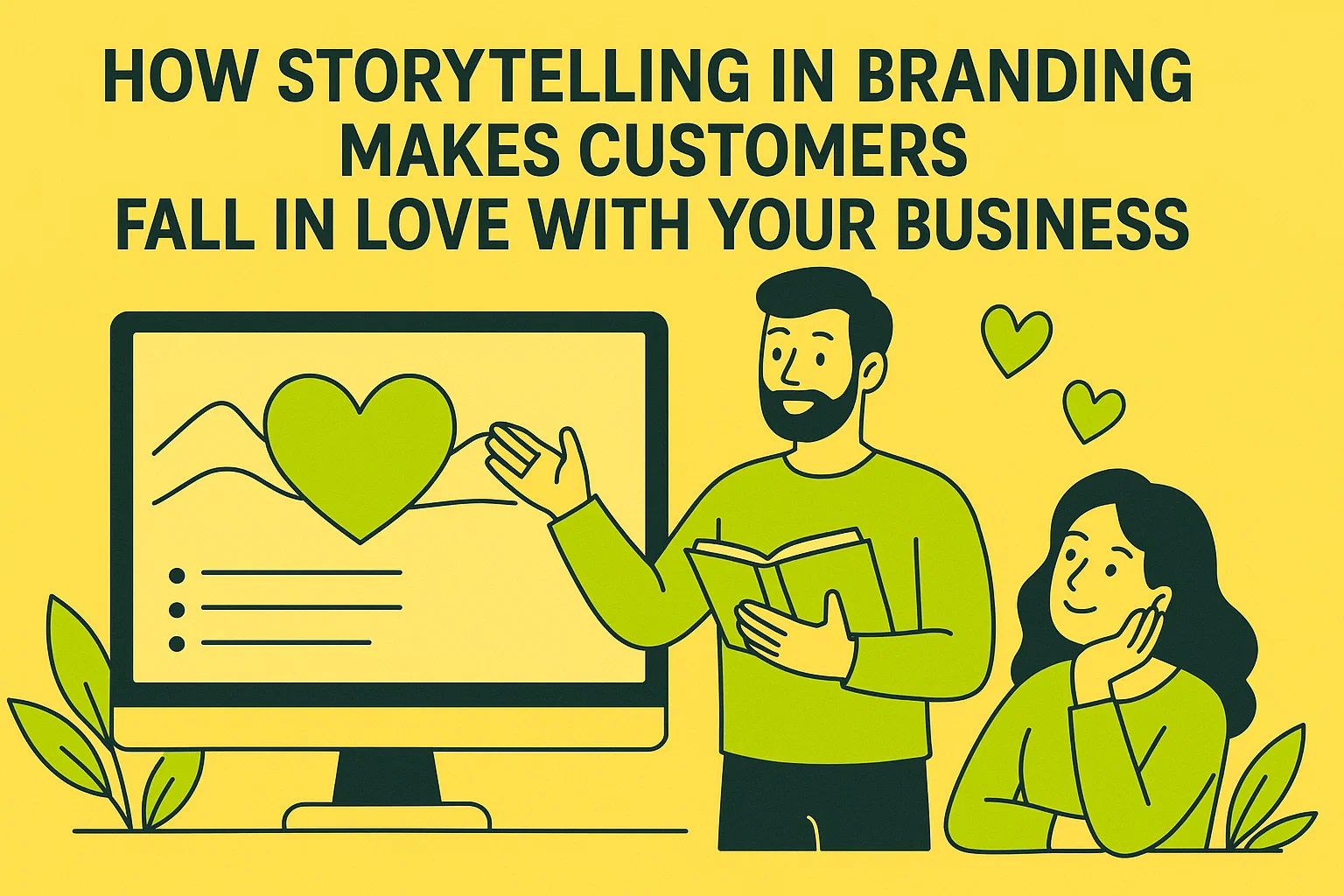Introduction:
In a world of information overload, consumers are bombarded with advertisements, promotions, and offers every day. So, how do you make your brand stand out and capture the hearts of your audience? The secret is storytelling.
Storytelling in branding is more than just a buzzword — it’s an incredibly powerful tool that helps humanize your brand, build emotional connections, and create lasting loyalty. When done correctly, storytelling can make customers not only trust your business but genuinely fall in love with it.
In this blog post, we’ll explore why storytelling in branding is essential, how it can benefit your business, and how you can craft stories that captivate and engage your audience.
1. Humans Are Hardwired for Stories
From the earliest days of civilization, storytelling has been an essential part of human culture. Whether it’s around a campfire, through books, or in movies, people have always shared and absorbed stories as a way of connecting, learning, and understanding the world around them.
This connection to storytelling is deeply embedded in our psychology. According to research, our brains are more likely to engage with stories than facts alone. This is because stories tap into emotions, making them more memorable and impactful.
In the context of branding, storytelling works because it helps your business move beyond just products or services and tap into something more profound — emotions. When consumers relate to your brand’s story, they are more likely to form an emotional connection, which can lead to long-term loyalty.
2. Storytelling Helps Build Emotional Connections
In today’s competitive market, emotional connections are key to fostering brand loyalty. People don’t just buy products; they buy the feelings associated with them. Whether it’s a sense of adventure, comfort, or inspiration, storytelling helps evoke those emotions, creating a stronger bond between your brand and your customers.
How Storytelling Builds Emotional Connections:
-
Relatability: A well-crafted story can make your customers feel like your brand understands their struggles, desires, and aspirations. This relatability fosters trust and loyalty.
-
Authenticity: Storytelling gives your brand a human touch, making it more approachable and genuine. When people connect with the story behind your business, they’re more likely to support your brand.
-
Inspiration: A great brand story can inspire your customers to take action, whether that’s buying your product, sharing your story, or simply aligning with your brand’s values.
For example, a business that shares its origin story — how it overcame obstacles or helped a community — can create a deep emotional connection with its customers. This connection can result in loyal customers who feel like they are part of your brand’s journey.
3. Storytelling Makes Your Brand Memorable
The key to being remembered in a sea of competitors is standing out, and storytelling is one of the most effective ways to do this. A memorable story sticks with people far longer than a tagline or product feature.
Think about iconic brands like Nike or Apple — their stories are so deeply embedded in their marketing that they’ve become synonymous with their identities. Nike is more than just athletic wear; it’s about inspiring people to push their limits and embrace personal challenges. Apple is about innovation, creativity, and changing the world.
By using storytelling, your brand can carve out its own unique identity that people will remember and identify with. A compelling narrative makes your brand stick in the minds of consumers, which increases the likelihood of repeat business and word-of-mouth marketing.
4. Storytelling Humanizes Your Brand
In a digital world where brands often feel faceless, storytelling humanizes your business. It helps people see the real people, values, and culture behind the brand. A humanized brand feels more approachable, trustworthy, and relatable.
How Storytelling Humanizes Your Brand:
-
Behind-the-scenes stories: Sharing the journey of how your products are made, who’s involved, or the values your team stands for helps customers feel like they are part of the process.
-
Customer success stories: Highlighting customer testimonials or success stories shows the positive impact your brand has had on real people’s lives.
-
Company culture: Sharing stories about your team, your office, or charitable initiatives shows that your brand cares about more than just profits.
When people feel like they’re engaging with real, relatable people behind the business, they are more likely to trust and support your brand. Humanizing your brand through storytelling fosters a sense of connection, loyalty, and authenticity.
5. Storytelling Helps Reinforce Your Brand Values
Every business has a set of core values that guide its mission, vision, and actions. Storytelling is one of the most effective ways to communicate your brand values to your audience in a way that feels authentic and engaging.
When you share stories that align with your values, you show your customers who you are and what you stand for. This helps build a stronger connection with like-minded consumers who share your values and beliefs.
For instance, if your brand values sustainability, you can tell the story of how you reduce waste in your production process, or share how your eco-friendly products have a positive impact on the environment. Aligning your story with your values not only attracts the right audience but also helps build trust with your existing customers.
6. Storytelling Creates a Sense of Community
When people connect with a brand story, they don’t just feel like they’re buying a product or service — they feel like they are part of a community. Storytelling helps create a sense of belonging among your customers, which strengthens their connection to your brand.
How Storytelling Builds Community:
-
Shared experiences: When your customers feel like they’re part of the journey, they are more likely to engage with your brand and share their own experiences with others.
-
Brand advocates: A compelling brand story encourages your customers to become brand advocates, sharing your message and spreading the word about your business.
-
Engagement: A well-told story invites customers to share their thoughts, memories, or feedback, creating a two-way conversation that strengthens your relationship with them.
The sense of community created through storytelling helps turn customers into loyal advocates who spread your brand’s message organically.
7. Storytelling Drives Action
At its core, storytelling drives action. Whether you want customers to make a purchase, sign up for a newsletter, or share your content, storytelling can motivate them to take the next step.
How Storytelling Drives Action:
-
Calls to action (CTA): A powerful story often ends with a clear and compelling call to action that encourages customers to take action — whether that’s buying, signing up, or contacting you.
-
Emotional triggers: Good stories tap into emotions, which are strong drivers of action. When your brand story resonates with a customer’s emotions, they’re more likely to act on it.
-
Inspiring loyalty: By connecting emotionally with customers through stories, you inspire them to remain loyal to your brand, thus increasing customer lifetime value.
A compelling brand story doesn’t just attract customers; it inspires them to engage with your brand and take action.
8. How to Create a Compelling Brand Story
Now that we understand why storytelling is crucial, how do you create a story that resonates with your audience? Here’s a simple formula to help you craft a compelling brand story:
-
Start with a relatable challenge or problem: Every great story begins with a challenge. What problem does your brand solve? What difficulties did your business face to get to where it is today? Show your audience that you understand their struggles.
-
Highlight your journey or solution: Once you’ve established the challenge, share how your brand overcame it or how it offers a solution to the problem. This is where you showcase your brand’s values, mission, and unique approach.
-
Add a personal touch: Humanize your brand by sharing the story behind your team, your inspiration, or the driving force behind your business.
-
End with a call to action: After telling your story, motivate your audience to take action, whether it’s purchasing your product, joining your community, or sharing your story.
Conclusion
In a digital age where consumers are inundated with options, storytelling in branding provides a way to cut through the noise and form meaningful connections with your audience. By weaving a compelling narrative, you can build emotional connections, establish trust, and inspire action — ultimately making your customers fall in love with your brand.
At Website Legends, we understand the power of storytelling. We help businesses craft narratives that resonate with their target audience, creating stronger brands and loyal customers. If you’re ready to tell your story and build a brand that stands out, contact Website Legends today to get started on your journey!
FAQ Section
1. Why is storytelling important in branding?
Storytelling allows brands to connect emotionally with their audience, making them more relatable and memorable. It helps create a sense of identity and trust, turning customers into loyal supporters.
2. How do I start telling my brand’s story?
Start by identifying the core values and purpose behind your business. Show how your brand solves a problem or improves the customer’s life. Then, humanize your brand by adding personal elements and challenges that made your journey unique.
3. Can storytelling improve customer engagement?
Absolutely! When customers feel emotionally connected to a brand, they are more likely to engage with your content, share their experiences, and become advocates for your brand.
4. How do I use storytelling to drive sales?
By creating a compelling brand story, you make your business relatable, inspiring your customers to take action. A well-crafted story can motivate customers to buy, sign up, or recommend your brand to others.
5. Can storytelling work for small businesses?
Yes! Storytelling is a powerful tool for businesses of all sizes. For small businesses, sharing your journey, values, and unique challenges can help differentiate you from larger competitors and attract loyal customers.


